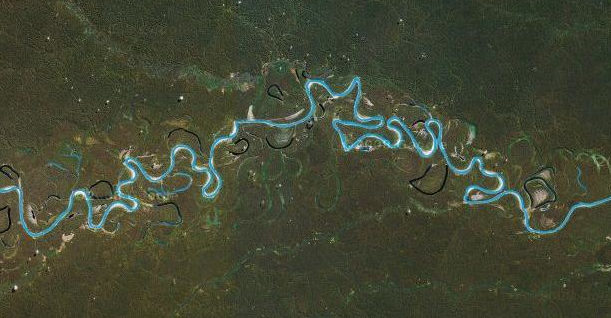Water Slides, Marbles and Rivers

If you have ever been on a large waterslide, you will know the feeling. You hold onto the rail at the threshold, the blue of the glassfibre slide falls away below you, beckoning you, daring you to jump and go. And of course, you do, for the evidence tells you that thousands have gone before you and survived the experience, and of course your status in the eyes of the world is at stake. The descent is fast and exhilarating, but the designers of those slides know a thing or two about physics and soon the descent slows as the steepness of the slide reduces, becoming nearly flat before shooting you out into the pool below. Great fun.
No less susceptible to the fundamentals of physics
Rivers are the same – a steep descent, a gentle slowing down the further from the source, and finally a real reduction in speed before they reach the sea. Its all about converting potential energy to kinetic energy, and a river system is no less susceptible to the fundamentals of physics than any other system. Using another analogy, a marble will roll down a steep slope in a straight line, but if that slope then open out onto a flat table top, the marble is then free to roll in any direction, particular if slight impediments are placed in its way.

The water has enough energy to carry the sand
So the high energy environment of a youthful river allows for down cutting, erosion and transport of material along its course. If we look at any mountain stream it is characterised by boulders and debris that is slowly being transported down the valley, but there is little fine sediment in those rivers – because the water has enough energy to carry the sand, the clay, and the silt away from their source. Using another analogy, if we fill a glass jar up with sediment and shake it – in other words put energy into the system – the sediment will remain in suspension if we keep on shaking. Once we stop the agitation, the sand will settle out pretty quickly, then followed by the silt and eventually the clay.
Tributaries provide additional water to the river channel
As the gradient becomes gentler, the river develops a mature profile. The potential energy has been reduced which in turn reduces the kinetic energy of the water. However the river is still able to erode and carry sediment but this happens over a wider area, rather than the deep downcutting of the youthful stage. Energy is however increased as tributaries provide additional water to the river channel.

The river is no longer constrained and thus migrates
Then comes the old age, where energy levels are really down. No more tributaries to augment energy levels, no more steep gradients to push up the kinetic energy. Like the marble rolling around on the table top, the river is no longer constrained and thus migrates back and forth across the flood plain. Silt and clay, which has been carried in suspension for great distances, is deposited in levees along the river course, as overbank deposits during flooding, and always in estuaries and deltas when the river meets the sea. Meanders mimic the rolling around of the marble as it slowly makes its way to the edge of the table, although meander migration has its own dynamics which we won’t go into here.
It would be a good idea to get the physics teacher into the classroom
In summary then, precipitation falls in elevated regions and flows downslope towards the ocean. The behaviour of the river is a function of its energy levels – high energy means erosion and sediment transport; low energy means deposition and meanderings. Perhaps it would be a good idea to get the physics teacher into the classroom for some cross-over teaching, enriching both the physics and geography classes. It would also be a good idea to get a jar, fill it with sediment, give it a shake and see what happens.

